Edible Expectations – When Will Your Cannabis Snack Kick In?
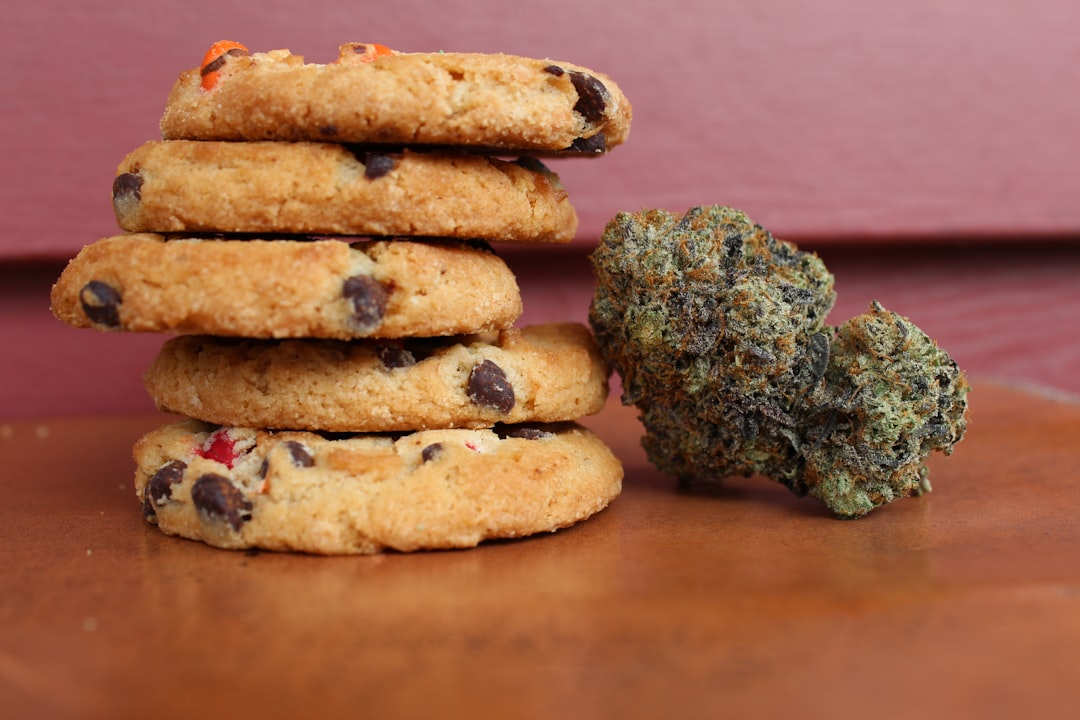
Understanding Edible Onset: The Science Behind Your Wait
How long do edibles take to kick in is one of the most common questions among cannabis users, and for good reason. Unlike smoking or vaping, edibles follow a completely different pathway through your body, creating unique timing challenges that can surprise even experienced users.
Quick Answer:
- Chewable edibles (gummies, brownies): 30-90 minutes to kick in
- Sublingual edibles (lozenges, tinctures): 15-30 minutes to kick in
- Peak effects: Around 2-3 hours after consumption
- Total duration: 4-12 hours depending on dose and individual factors
- Golden rule: Wait at least 2 hours before taking more
The popularity of edibles has skyrocketed because they offer discreet consumption without the respiratory risks of smoking. When you eat a cannabis-infused gummy or brownie, the active compounds must travel through your digestive system and liver before reaching your bloodstream - a process that's vastly different from inhaled cannabis.
This digestive journey creates both the blessing and curse of edibles: longer-lasting effects but unpredictable timing. Many first-time users make the mistake of taking more when they don't feel anything after 30 minutes, only to find themselves overwhelmed hours later when both doses hit simultaneously.
As Max Shemesh from Zaleaf, I've spent years helping customers steer edible timing through our high-quality cannabinoid products and have seen how long do edibles take to kick in varies dramatically between individuals. My experience in the hemp industry has taught me that understanding onset timing is crucial for a safe, enjoyable experience.
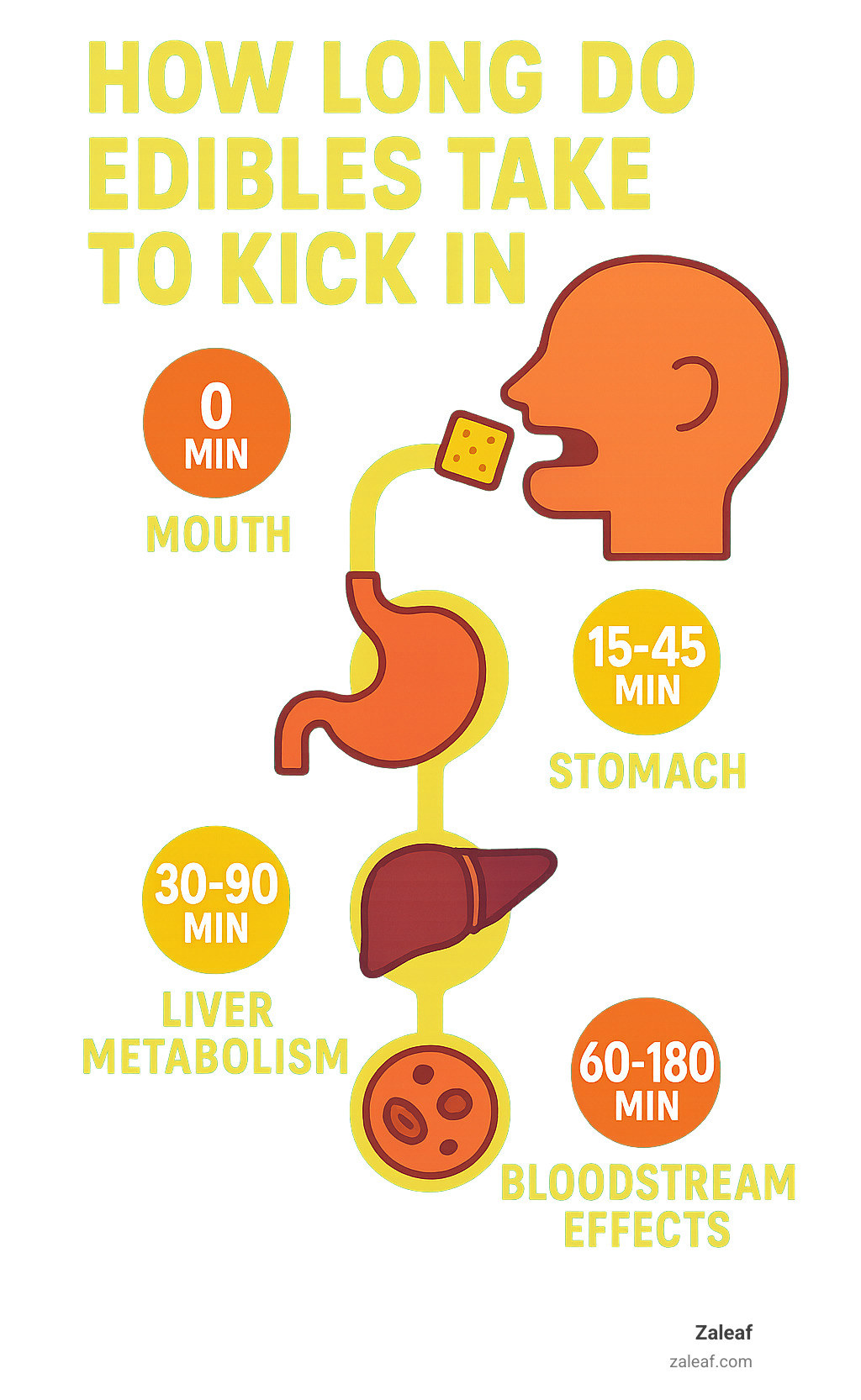
Related content about how long do edibles take to kick in: - how long does an edible last - cannabis gummies - edible cannabis
Why Timing Matters
Understanding how long do edibles take to kick in isn't just academic curiosity—it's essential for safety and enjoyment. For first-time users, misjudging onset time can lead to overconsumption and an uncomfortable experience that might last 8-12 hours. Even experienced users need to plan their activities around edible timing, whether they're using cannabis for relaxation, pain relief, or sleep.
The delayed onset of edibles has led to countless emergency room visits from people who thought their edible "wasn't working" and took additional doses. Research analyzing over 100,000 tweets about cannabis experiences found that unpredictable duration was one of the most commonly reported adverse effects with edibles.
Edibles 101 – What Makes Them Different?
Walk into any dispensary today and you'll find an amazing variety of cannabis edibles. There are classic baked goods like brownies and cookies, colorful gummies in every flavor imaginable, refreshing beverages, and even sophisticated sublingual products like lozenges and tinctures. But here's what's fascinating—despite all these different forms, they don't all work the same way in your body.
The magic (and sometimes frustration) of edibles comes down to cannabinoids like THC and CBD being processed completely differently than when you smoke or vape. When you're wondering how long do edibles take to kick in, you're really asking about a complex biological process called first-pass metabolism.
Here's what happens: when you eat that gummy or brownie, it travels through your digestive system to your stomach, then moves to your small intestine where the cannabinoids get absorbed. But they're not done yet—next stop is your liver, where something really interesting occurs.
Your liver acts like a cannabis chemistry lab, converting THC into 11-hydroxy-THC. This new compound is actually more potent than regular THC and creates that distinctive "full-body" feeling that edible users know and love. It's why many people describe edible highs as feeling more intense and body-focused compared to smoking.
This liver conversion process also explains why research shows that 1 mg of edible THC can feel as strong as about 5.71 mg of smoked THC. That's a huge difference that catches many people off guard, especially when they're used to other consumption methods.
Sublingual vs. Chewable Biology
Not all edibles take the scenic route through your digestive system. Sublingual products—those designed to dissolve under your tongue like lozenges, lollipops, and tinctures—are the speed demons of the edible world.
When you hold these products under your tongue, the cannabinoids absorb directly through your mucous membranes and zip straight into your bloodstream. No stomach, no liver processing—just a direct ticket to your blood-brain barrier. This is why sublingual products typically have much faster onset speed, often kicking in within 15-30 minutes.
Chewable edibles like gummies and brownies, on the other hand, must complete that full digestive journey we talked about earlier. They take longer to kick in (usually 30-90 minutes), but the effects tend to last longer because of that liver conversion process.
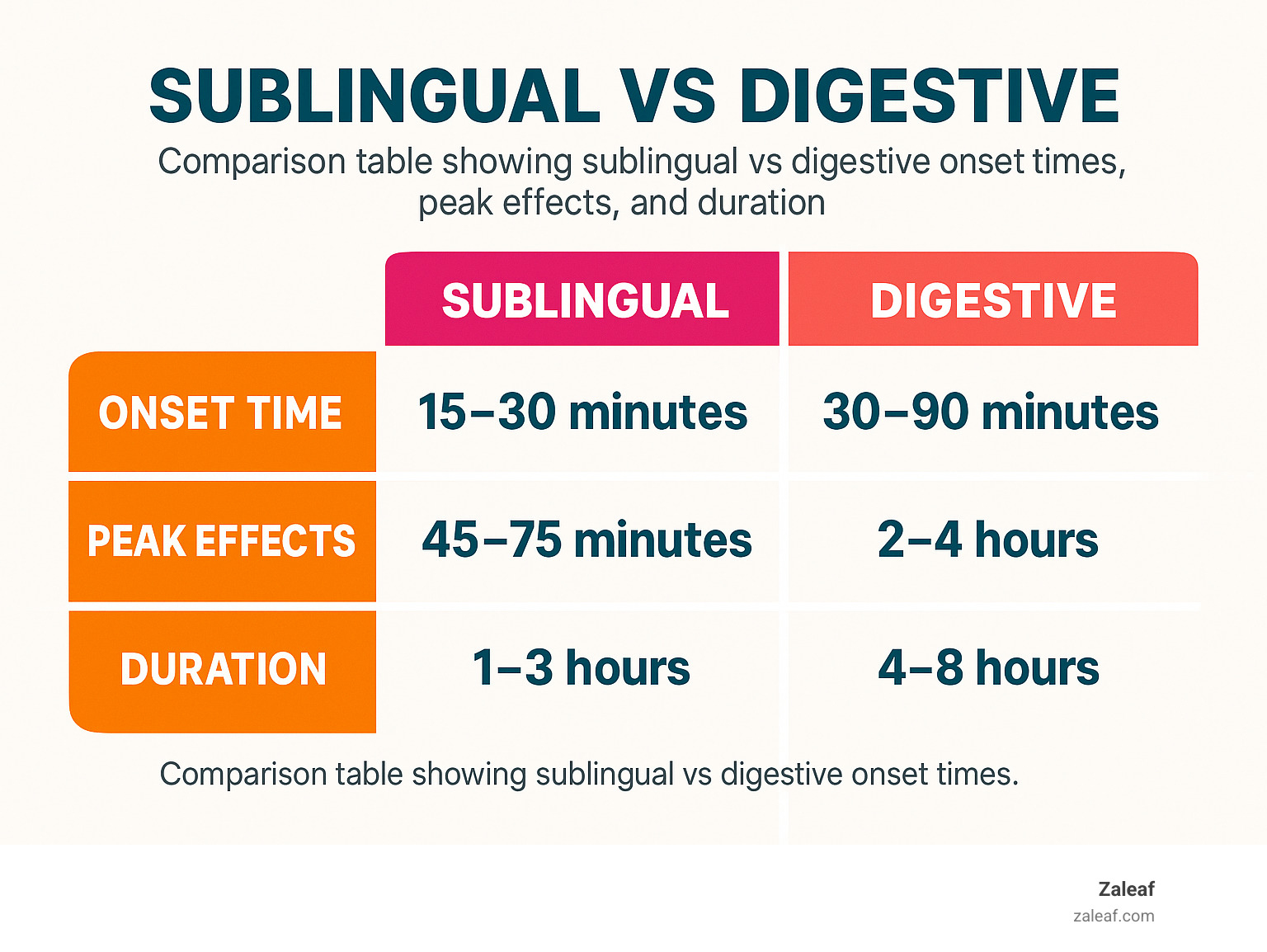
The trade-off is real: sublingual products give you faster results but often with less intensity and shorter duration. Digestive edibles make you wait longer, but they typically deliver more powerful, longer-lasting effects. Understanding this difference is crucial when you're planning your cannabis experience and trying to predict how long do edibles take to kick in for your specific product choice.
How Long Do Edibles Take to Kick In?
Here's the truth about how long do edibles take to kick in: it's not as predictable as we'd all like it to be. While most people start feeling effects within 30-60 minutes, some folks might wait up to 2 hours before anything happens. It's like waiting for a delayed text message—you know it's coming, but the timing keeps you guessing.
The science behind this timing comes down to your body's digestive process. When you eat a cannabis gummy or brownie, those cannabinoids need to travel through your stomach, get absorbed in your small intestine, and then pass through your liver for processing. Your liver does something pretty interesting here—it converts THC into 11-hydroxy-THC, which is actually more potent than regular THC and creates that distinctive "whole-body" feeling that edible users know and love.
Most people reach their peak effects around 3 hours after eating an edible. This means what you're feeling at the one-hour mark isn't even the full experience yet. A landmark study from 1980 tracking 20mg THC edibles found that participants hit their highest blood levels right around that 3-hour mark, and modern research continues to confirm this timeline.
This delayed and extended timeline explains why edibles have sent so many people to emergency rooms. Social media analysis shows that 12% of users report unexpectedly intense effects from edibles, usually because they thought their first dose "wasn't working" and took more. Don't be that person—patience really is a virtue with edibles.
For more detailed information about the science behind these timelines, this Scientific research on edible pharmacokinetics dives deep into how your body processes cannabis edibles.
"How long do edibles take to kick in" for Sublingual Products
If you're looking for faster results, sublingual products like lozenges, lollipops, and tinctures are your best friends. These clever products bypass your digestive system entirely by absorbing directly through the tissues under your tongue and inside your cheeks.
The key to sublingual success is technique. You need to hold that lozenge or tincture under your tongue for several minutes—no cheating and swallowing right away. When done correctly, you can start feeling effects in just 15-30 minutes, which is pretty impressive compared to traditional edibles.
The trade-off? Sublingual effects typically don't last quite as long since they skip your liver's conversion process. But for users who need predictable timing or faster relief, this rapid onset makes sublingual products incredibly valuable.
"How long do edibles take to kick in" for Chewable Gummies & Brownies
Traditional chewable edibles—your classic gummies, brownies, chocolates, and baked goods—take the scenic route through your digestive system. After you swallow, they need to survive your stomach acid, make their way through your small intestine, and then get processed by your liver before you feel anything.
This digestive journey typically takes 30-90 minutes, but can stretch to 2 hours or even longer depending on what else is happening in your stomach. If you've just finished a big, fatty meal, your edible might take longer to kick in, but the effects could actually be stronger once they arrive. This happens because cannabinoids are fat-soluble, so they bind with the fats in your meal and get absorbed more effectively.
The unpredictable nature of this process is exactly why the "start low, go slow" approach is so important with chewable edibles. Your body's digestive transit time can vary based on everything from what you ate for lunch to how fast your metabolism runs on any given day.
Why Your Experience Varies: Key Influencing Factors
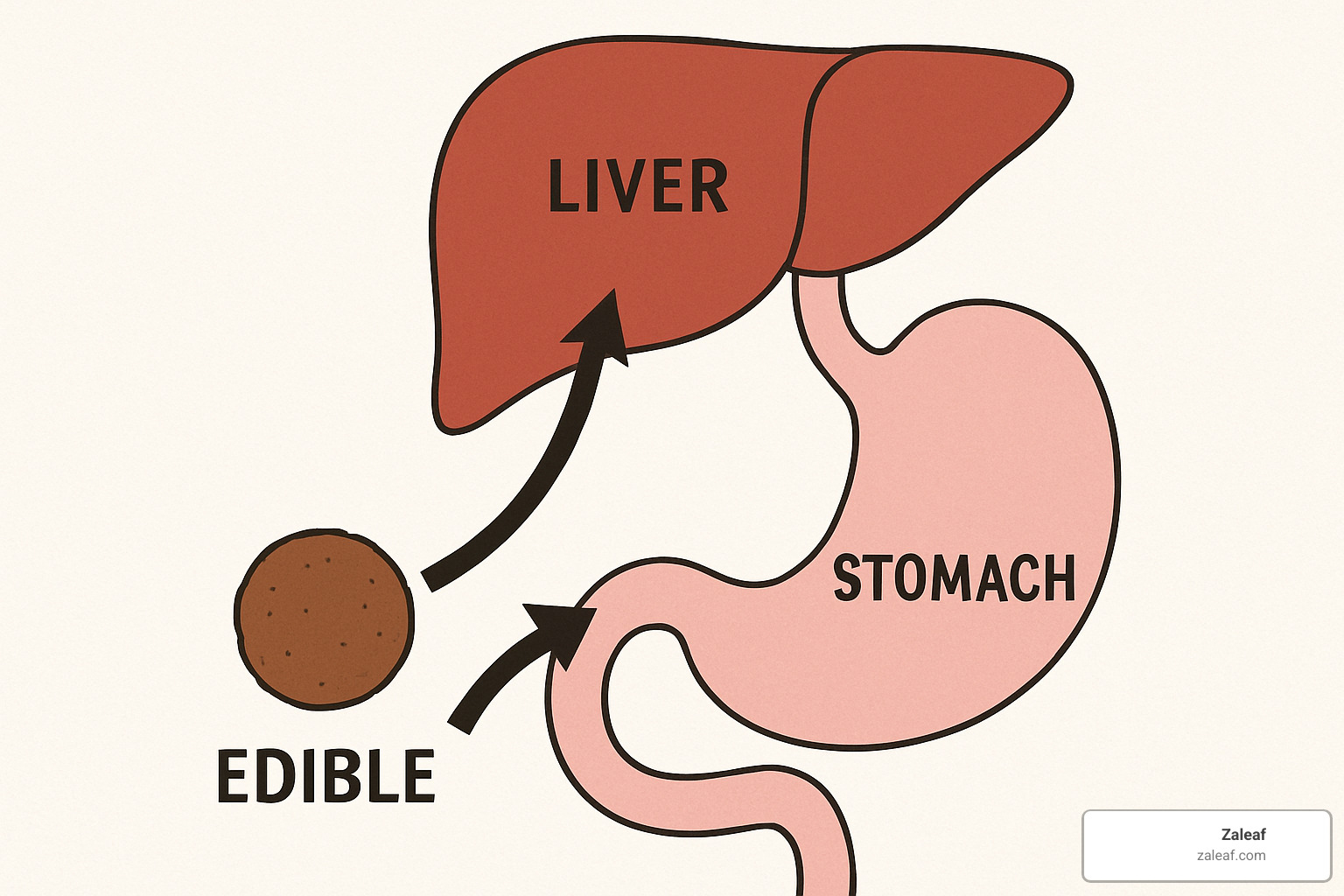
Ever wonder why your friend feels their gummy in 30 minutes while you're still waiting after an hour? The answer to how long do edibles take to kick in isn't one-size-fits-all. Your body processes edibles in its own unique way, creating a personalized timeline that can vary dramatically from person to person.
Think of your body as a custom-built factory for processing cannabis. Your individual metabolism acts like the speed setting on this factory's conveyor belt. Some people run a high-speed operation that breaks down cannabinoids quickly, while others operate at a more leisurely pace. Age plays a role here too—younger people typically have faster metabolisms, though this isn't always the case.
Body composition matters more than you might expect. Since cannabinoids love to bind with fat, your body fat percentage influences how they distribute and store in your system. People with higher body fat may experience longer-lasting effects, while those with lower body fat might feel effects more quickly but for shorter periods.
Your gender can also influence timing. Research shows that women often process THC differently than men, partly due to hormonal differences and varying levels of certain liver enzymes. Even your menstrual cycle can affect how edibles hit you, which explains why the same dose might feel different at different times of the month.
Tolerance levels create perhaps the most dramatic differences in edible experiences. If you're a daily cannabis user, your body has built up a resistance that can significantly delay and diminish edible effects. On the flip side, if you're new to cannabis or take regular breaks, you might find edibles hit you faster and stronger than expected.
The specific product formulation you choose also influences your timeline. Modern edibles use different technologies to improve absorption. Some manufacturers use nano-emulsion techniques that break cannabinoids into tiny particles, potentially reducing onset time to 30-45 minutes instead of the typical hour-plus wait.
Dose strength affects not just intensity but timing too. Surprisingly, higher doses don't always kick in faster—sometimes they take longer because your liver needs more time to process the increased cannabinoid load. The entourage effect from different terpene profiles can also subtly influence how quickly you feel effects, though this varies significantly between products.
Fast vs. Slow Metabolisms
Your genetic makeup includes specific instructions for liver enzymes that break down cannabinoids. These enzyme variations, particularly in the cytochrome P450 family, determine whether you're naturally a fast or slow processor of THC.
Fast metabolizers often complain that edibles "don't work" for them. In reality, their bodies are breaking down the THC so efficiently that effects feel weaker or shorter-lived. If this sounds like you, you might need higher doses or products specifically designed for extended release.
Slow metabolizers experience the opposite challenge. They might feel overwhelmed by standard doses because their bodies process cannabinoids more gradually, creating longer-lasting and potentially more intense effects.
Food in the Stomach
What you eat—and when you eat it—dramatically changes your edible experience. Taking edibles on an empty stomach typically speeds up onset to 30-45 minutes because there's nothing blocking the path to absorption. However, this faster route can also lead to more intense effects that might feel overwhelming.
Eating edibles with a meal, especially one containing healthy fats like avocado, nuts, or olive oil, usually delays onset by 30-60 minutes. But here's the trade-off: you'll likely absorb more of the cannabinoids, leading to stronger and longer-lasting effects overall. The fats act like helpful escorts, guiding cannabinoids through your digestive system more effectively.
Fasting states can be unpredictable with edibles. While you might feel effects faster, you're also more likely to experience side effects like nausea or dizziness. Most experienced users recommend having at least a light snack before taking edibles, especially if you're trying a new product or dose.
For more detailed information about how food timing affects your cannabis experience, check out this Scientific research on food impact.
How Long Do Edible Effects Last & How They Compare to Smoking
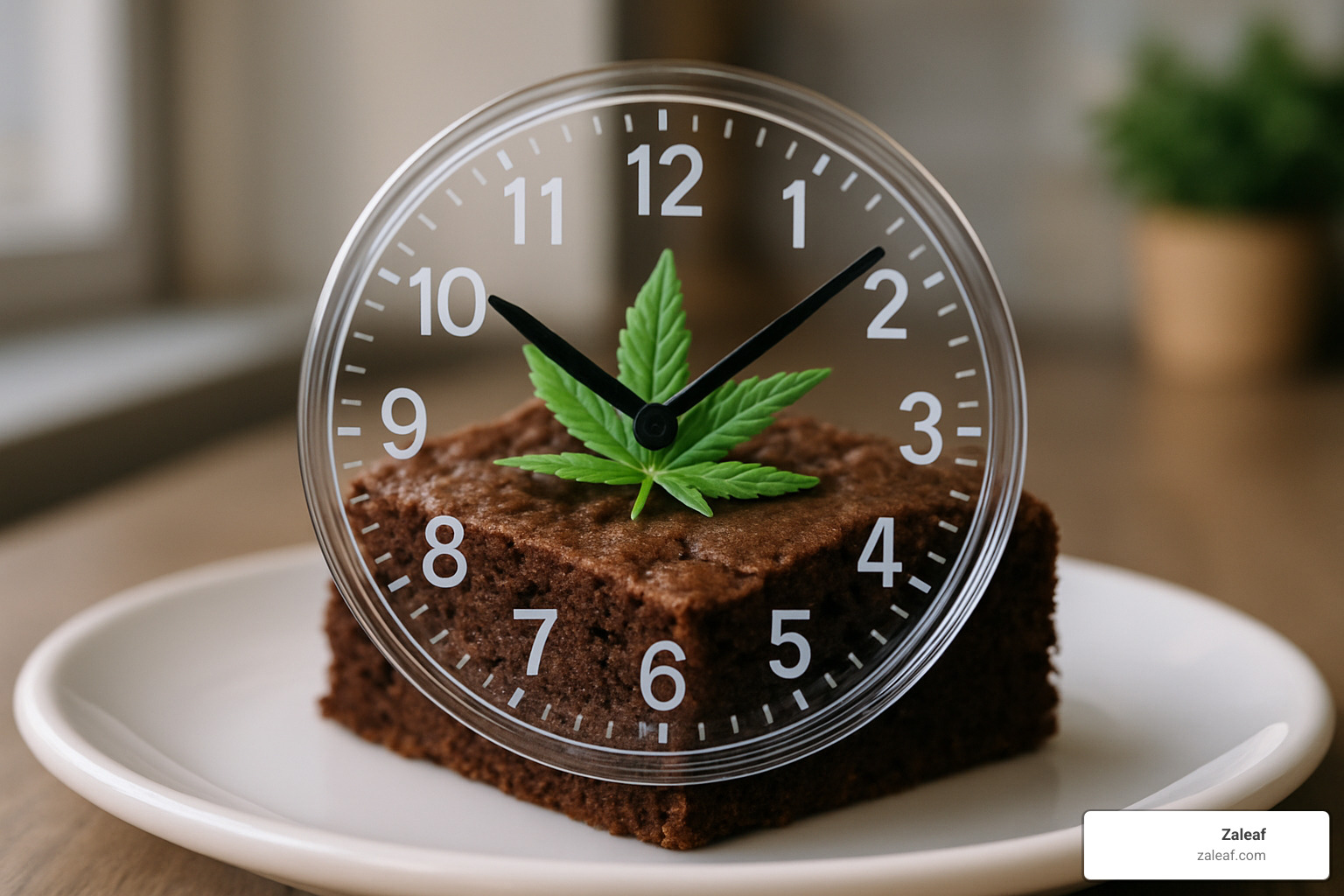
Here's where edibles really shine—and where they demand respect. Once you understand how long do edibles take to kick in, you need to prepare for the journey ahead. Unlike the quick in-and-out experience of smoking, edibles are more like boarding a slow train that doesn't stop for hours.
Most people experience edible effects for 4-12 hours, with some gentle aftereffects potentially lingering for up to 24 hours. This isn't a quick coffee break high—it's a commitment. When you eat that gummy, you're essentially saying "I'm going to feel this for the rest of my day (and possibly into tomorrow)."
The peak intensity usually hits around 2-3 hours after consumption and can hold steady for 1-3 hours before gradually fading. Think of it like a gentle wave that builds slowly, crests for a while, then slowly recedes. This sustained experience makes edibles incredibly valuable for people managing chronic pain, severe insomnia, or anxiety that needs all-day relief.
Comparing edibles to other consumption methods reveals just how different they really are. Smoking or vaping cannabis kicks in within 2-10 minutes but typically fades within 1-4 hours. Sublingual tinctures fall somewhere in the middle, starting within 15-30 minutes and lasting 2-4 hours. Digestive edibles are the marathon runners of cannabis—slow to start but built for endurance.
This extended timeline makes edibles perfect for certain situations but challenging for others. They're fantastic when you want consistent relief throughout a long flight, a full night's sleep, or an entire day of chronic pain management. They're less ideal when you want to "test the waters" or need precise timing control.
The longer duration also means edibles carry minimal respiratory risks compared to smoking. You're not exposing your lungs to any combustion byproducts or potential toxins—just the natural metabolic process your liver handles every day.
For a deeper dive into exactly what to expect throughout your edible journey, check out The Edible Countdown: Exactly How Long Your High Will Last.
Smart Dosing, Safety, and Storage
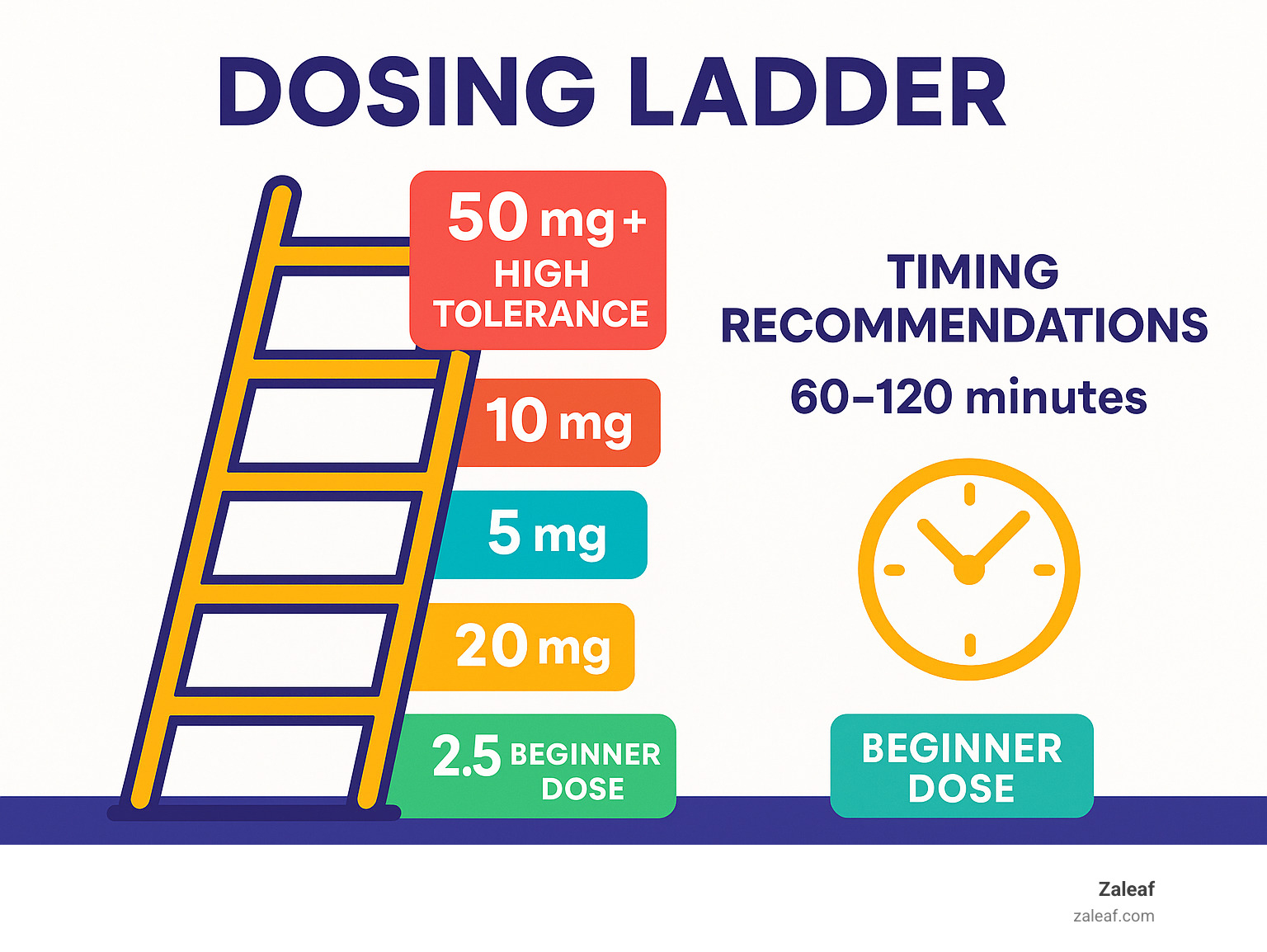
Getting your edible dose right is like learning to drive—start slow, stay alert, and build confidence gradually. The difference between a perfect evening and an uncomfortable 8-hour ordeal often comes down to a few milligrams and your patience with timing.
The cannabis industry has settled on 10mg THC as a standard serving, but this "standard" can be overwhelming for newcomers. Think of it like alcohol—a standard drink affects everyone differently based on size, experience, and what they ate that day. First-time users should start with just 2.5-5mg THC and treat it like a science experiment with yourself as the subject.
Here's what works for most people: beginners need 1-2.5mg THC, while occasional users can handle 2.5-5mg THC comfortably. Regular users typically find their sweet spot around 5-10mg THC, and those with high tolerance might need 10-20mg or more. You can always take more tomorrow, but you can't take less once it's in your system.
Microdosing has become incredibly popular for good reason. Taking tiny amounts—around 1-2.5mg regularly—gives you therapeutic benefits without feeling "high." Many people use this approach for anxiety, pain, or sleep issues while maintaining complete functionality throughout their day.
Since how long do edibles take to kick in varies so dramatically between people, the golden rule remains sacred: wait at least 2 hours before taking more. I've seen countless people make the rookie mistake of eating another gummy after an hour, only to have both doses hit simultaneously around the 90-minute mark.
Always read your product labels like your comfort depends on it—because it does. Some packages contain multiple servings, and accidentally eating an entire chocolate bar meant to be divided into ten pieces is a common mishap. Look for products that undergo third-party testing to ensure you're getting exactly what the label promises. At Zaleaf, all our products meet these testing standards because accurate dosing is crucial for a positive experience.
Legal limits vary by state, but most recreational markets cap individual packages at specific THC amounts. Understanding these limits helps you choose appropriate products and avoid accidentally purchasing something stronger than intended.
For detailed guidance on understanding what you're buying, check out More info about label reading.
Avoiding the Dreaded "Too Much"
The "wait 2 hours" rule isn't just a suggestion—it's your safety net. Even experienced users can misjudge timing, especially when trying new products or eating edibles on an empty stomach versus with a meal.
If you do end up taking too much, while uncomfortable, cannabis overconsumption isn't dangerous. You might experience anxiety, rapid heartbeat, nausea, or paranoia, but these effects will pass. Stay hydrated, find a quiet, comfortable space, and practice slow, deep breathing. Some people find that CBD can help counteract THC effects if you have it available.
Call a trusted friend if you're feeling anxious—sometimes just talking to someone who understands can provide enormous comfort. Avoid driving or making important decisions until the effects fully wear off, which could take 8-12 hours depending on your dose.
Proper Storage Essentials
Proper storage protects both your investment and your household safety. Store edibles in child-resistant containers in a cool, dark place away from heat and direct sunlight. Your medicine cabinet, a dedicated drawer, or a small lockbox work perfectly.
Most edibles maintain potency for 6 months to 2 years when stored correctly, though you should always check expiration dates. Heat and light degrade cannabinoids over time, so avoid storing products in cars, near windows, or in warm areas like attics.
Keep edibles clearly labeled and separate from regular food. This prevents accidental consumption by family members, roommates, or guests who might mistake your cannabis chocolate for regular candy. Cannabis can be toxic to pets, so secure storage isn't just about keeping kids safe—it's about protecting your furry family members too.
Consider investing in a small, discrete storage container specifically for cannabis products. This keeps everything organized, secure, and properly labeled while maintaining the discrete approach that makes edibles appealing in the first place.
For comprehensive information about storage best practices and safety considerations, read Cannabis Edibles: How Long Do They Linger.
Frequently Asked Questions about Edible Timing
Can I speed up or slow down onset intentionally?
You absolutely have some control over how long do edibles take to kick in, and understanding these tricks can help you plan your experience better. If you're hoping for faster effects, try taking your edible on an empty stomach - this can reduce onset time by 15-30 minutes since there's less food competing for your digestive system's attention.
Sublingual products like lozenges or tinctures are your best bet for speedy onset, often kicking in within 15-30 minutes. Some people also find that taking a short tolerance break makes their next edible experience both faster and more intense.
To slow things down and create a gentler ride, eat your edible with a meal that includes healthy fats like avocado, nuts, or olive oil. While this might delay when you feel effects by 30-60 minutes, many users report smoother, more comfortable experiences that last longer. The fats actually help your body absorb the cannabinoids more effectively, so you're not sacrificing potency for comfort.
Are THC and CBD edibles different in timing?
THC and CBD edibles follow remarkably similar timing patterns - both typically take 30-90 minutes to kick in and reach peak levels around the same time. The real difference lies in what you'll actually feel when they start working.
THC edibles produce obvious psychoactive effects that are hard to miss. You'll know when that gummy hits because you'll feel the characteristic body high, mood changes, or altered perception. CBD edibles, on the other hand, work more quietly behind the scenes. They provide therapeutic benefits like reduced anxiety, pain relief, or better sleep without any intoxication.
This means you might not even realize your CBD edible has kicked in unless you're specifically treating symptoms. Many people notice they simply feel more relaxed or that their chronic pain has eased, but there's no "high" to signal the onset like with THC products.
What should I do if I feel uncomfortably high for hours?
First, take a deep breath and remind yourself that how long do edibles take to kick in also applies to how long they take to wear off - this feeling will pass, even though it doesn't feel like it right now. Cannabis overconsumption is uncomfortable but not dangerous.
Find a calm, comfortable space where you feel safe. Stay hydrated with water (avoid alcohol), and try gentle activities like listening to soothing music, taking a warm shower, or practicing slow, deep breathing. Some people swear by the calming effects of chewing on black peppercorns or taking a few drops of CBD oil, which may help counteract some of THC's intensity.
Avoid driving, operating machinery, or making important decisions until you're completely sober. If you experience severe symptoms like chest pain or difficulty breathing, don't hesitate to seek medical attention, though these reactions are extremely rare with cannabis alone. Most uncomfortable edible experiences resolve within 4-8 hours, and you'll likely feel much better after a good night's sleep.
Conclusion
Mastering how long do edibles take to kick in transforms your cannabis experience from guesswork into confident enjoyment. While the general timeline of 30-90 minutes for chewable edibles and 15-30 minutes for sublingual products gives you a starting point, your unique body chemistry means your experience might be different each time.
The beauty of edibles lies in their longer-lasting effects compared to smoking or vaping, but this same quality demands respect and patience. When you choose an edible, you're committing to a journey that could last 4-12 hours—making proper timing and dosing absolutely essential.
Your success with edibles comes down to three simple principles: start low, go slow, and wait. That two-hour rule isn't just a suggestion—it's your safety net against an uncomfortable experience that could last all day. Whether you're using cannabis for relaxation after work, managing chronic pain, or improving sleep, understanding onset timing helps you plan your experience perfectly.
At Zaleaf, we've seen countless customers find the joy of edibles when they understand the timing. Our third-party tested products provide the consistency you need to build confidence with dosing. With our fast shipping and discreet packaging, you can explore cannabis edibles without worry, knowing exactly what you're getting every time.
The cannabis world can feel overwhelming with all its variables—metabolism differences, tolerance factors, and product formulations. But here's the encouraging truth: once you understand how long do edibles take to kick in for your body, edibles become one of the most reliable and enjoyable ways to consume cannabis.
For deeper insights into edible duration and effects, explore From Start to Finish: How Long THC Gummies Affect You.
Your cannabis journey is uniquely yours. What works perfectly for your friend might not suit you at all, and that's completely normal. Start conservatively, stay patient with timing, and always prioritize safety. With these principles guiding you, edibles can become a trusted part of your wellness routine—predictable, effective, and perfectly timed to fit your life.

